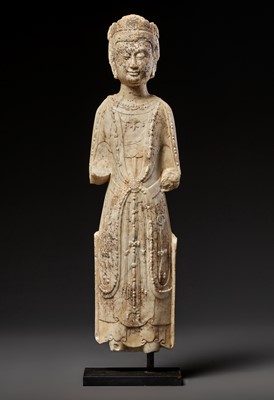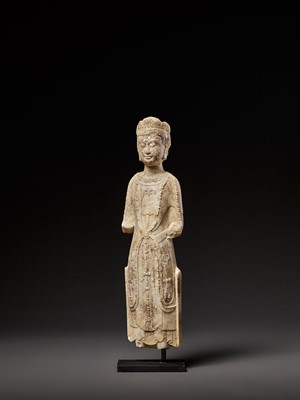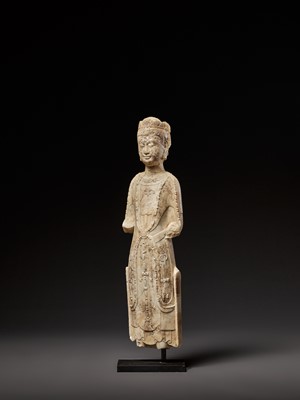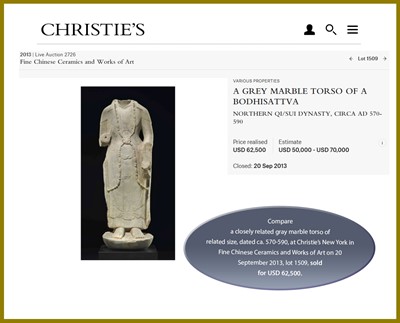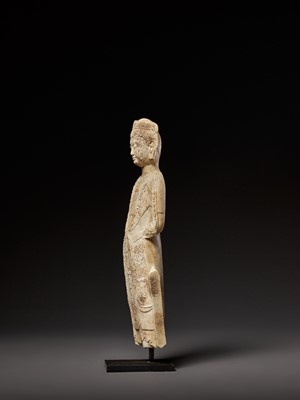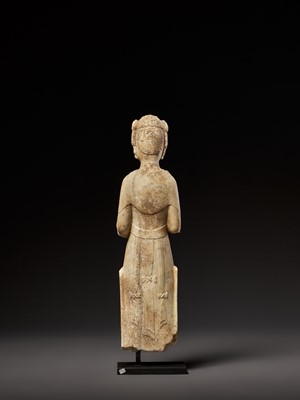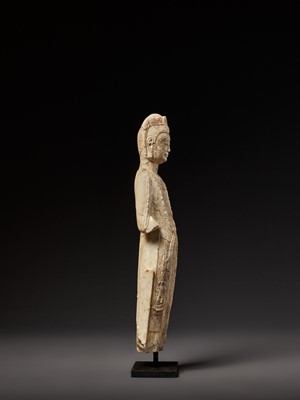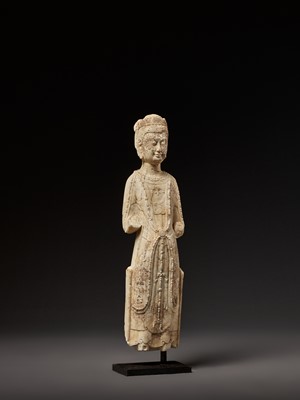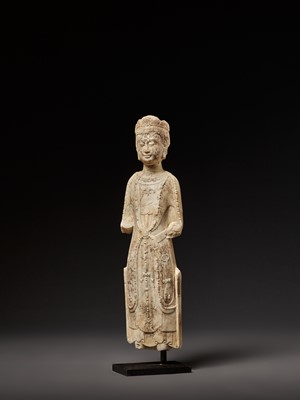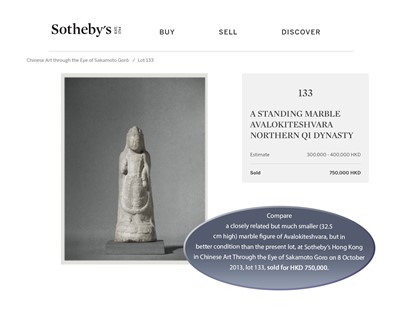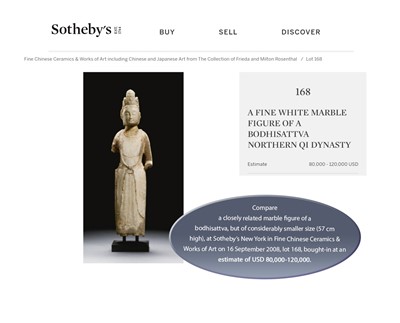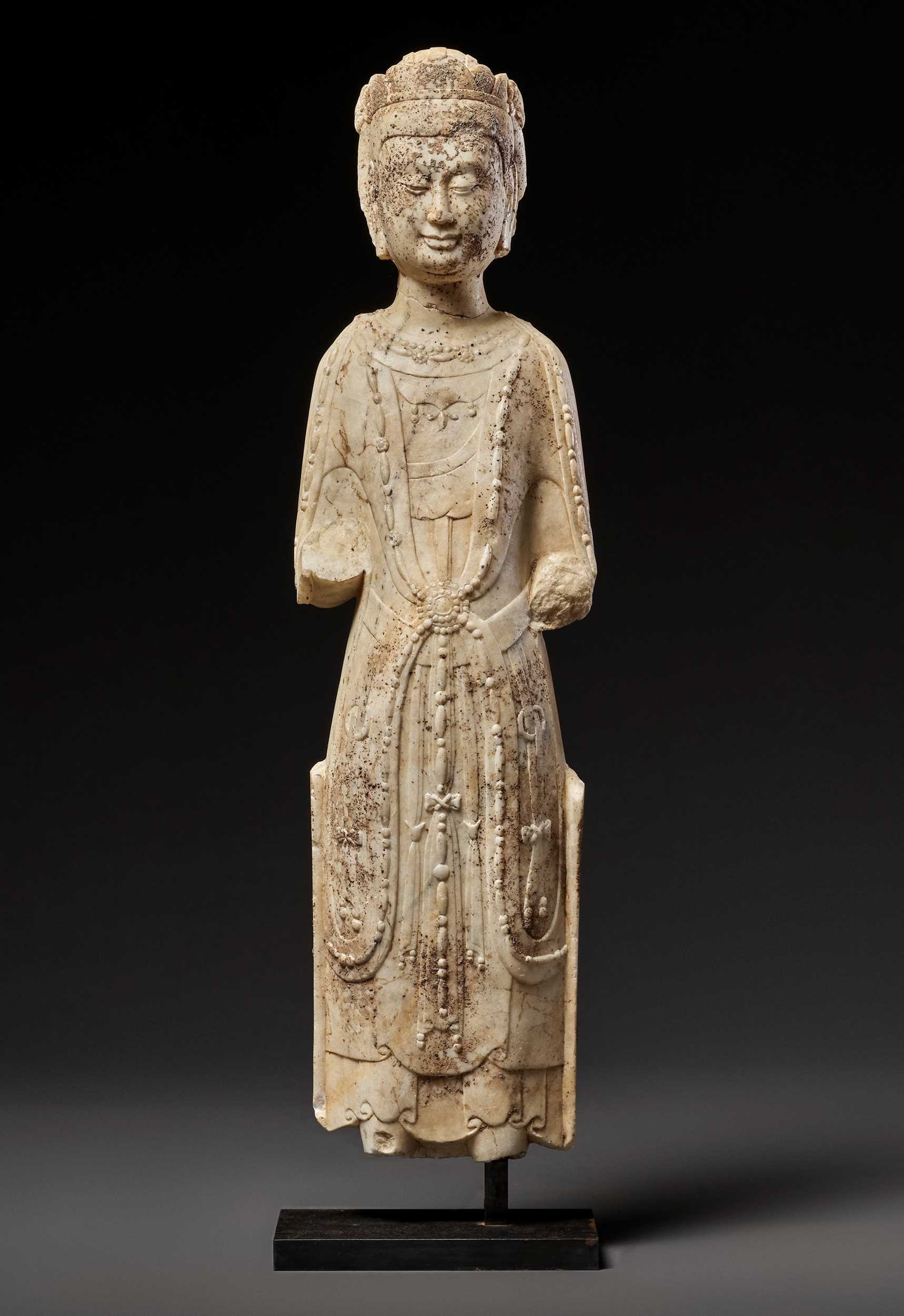16th Oct, 2021 10:00
TWO-DAY AUCTION - Fine Chinese Art / 中國藝術集珍 / Buddhism & Hinduism
362
A LARGE WHITE MARBLE FIGURE OF AVALOKITESHVARA, NORTHERN QI DYNASTY
北齊大型漢白玉觀音立像
Sold for €15,168
including Buyer's Premium
China, 550-577. The slender figure standing in a serene pose and modeled in a gently rounded form, wearing an elegant long flowing robe leaving the chest bare and draped with thin scarves. A long, beaded necklace draping down from either shoulder to interlink through a ring at the waist and then falling along each leg. The softly modeled face with heavy-lidded downcast eyes below gently arched eyebrows and full lips pursed to form a subtle smile, the pleated hair secured by a diadem.
Provenance: A prominent private collection in Versailles, France, by repute acquired at Parke-Bernet Galleries in New York and thence by descent in the same family to the last owner.
Condition: Excellent condition, commensurate with age. Wear, weathering, structural cracks, losses and chips. Very few and minimal touchups. Authentic and naturally grown sedimentary encrustations, which sit tightly and cannot be removed. The failure envelope of the various losses is generally consistent with what would be expected of an archeological find from the region and period. The head, however, was broken off at some point during or after the excavation, and subsequently reattached. The marble with an unctuous, variegating creamy-white to russet patina.
Weight: 46.9 kg (incl. base)
Dimensions: Height 90 cm (excl. base) and 98 cm (incl. base)
Mounted to an associated metal base. (2)
This delicately carved marble figure is remarkable for its crisp lines that capture the elegant characteristic of the sculpture of the Northern Qi dynasty. The sense of ethereal grace of Avalokiteshvara is heightened by the subtly carved layers of minimalist robes and by the simple yet elegant ornaments decorating the figure. According to Osvald Siren in ‘Chinese Marble Sculptures of the Transition Period’, Bulletin of the Museum of Far Eastern Antiquities, no. 12, Stockholm, 1940, pp. 473-96, marble figures carved in this specific and distinct style, where the figure is modeled in a gently rounded form with the details worked in low-relief carving, were made for only a short period in the second half of the sixth century.
Buddhism flourished during the Northern Qi dynasty, which saw a great increase in the production of statues and a proliferation of styles. The Qi aristocracy, headed by a military class of nomadic origin, was not only hostile to Chinese influence, but it also had a predilection for the foreign and exotic, especially in art. Hence, a style influenced by the Gupta art of India acquired pre-eminence soon after the Northern Qi dynasty came to power. Northern Qi figures are generally clad in thin, clinging robes, with an emphasis on portraying the solidity of the body rather than decorative drapery, which was characteristic of figures during the preceding Wei dynasty. This emphasis on the body went hand in hand with increased three-dimensionality. Thus, while Wei dynasty Buddhist figures form a relief with their body nimbuses, Northern Qi sculptures often stand free of their backgrounds.
Auction result comparison: Compare a closely related marble figure of a bodhisattva, but of considerably smaller size (57 cm high), at Sotheby’s New York in Fine Chinese Ceramics & Works of Art on 16 September 2008, lot 168, bought-in at an estimate of USD 80,000-120,000. Compare also a closely related but much smaller (32.5 cm high) marble figure of Avalokiteshvara, but in better condition than the present lot, at Sotheby’s Hong Kong in Chinese Art Through the Eye of Sakamoto Goro on 8 October 2013, lot 133, sold for HKD 750,000, and a closely related gray marble torso of related size, dated ca. 570-590, at Christie’s New York in Fine Chinese Ceramics and Works of Art on 20 September 2013, lot 1509, sold for USD 62,500.
北齊大型漢白玉觀音立像
中國,550-577年。觀音身形修長端莊,身軀略顯清瘦,兩肩削圓,胸口平實,胸前掛有項鍊,身披天衣和瓔珞,瓔珞於腹部交叉成X形,穿著長裙,裙帶繫紥於腰際。頭上戴冠,臉型長圓,兩頰豐腴柔軟,眉毛以弧形陰線刻劃,兩眼下視,可見眼內瞳仁,鼻樑略寬,兩翼飽滿,嘴部雕琢細膩,展現出微妙的笑容。
來源:法國凡爾賽一知名私人收藏,據説購於紐約 Parke-Bernet Galleries 藝廊,保存在同一家族直至最後一位持有者。
品相:狀況極佳,與年齡相稱。 磨損、風化、結構裂縫、缺損和碎屑。極少的修整。自然產生的結殼,緊緊依附在表面,無法去除。其狀況與考古預期一致。然而,頭部在考古過程中或之後被折斷,經過重新連接。大理石具有油潤的乳白色至赤褐色光澤。
重量:46.9 公斤 (含底座)
尺寸:高 90 厘米 (不含底座) ,總98 厘米
金屬支座。(2)
這尊精雕細琢的大理石雕像,以其鮮明的線條體現了北齊雕塑的優雅而令人印象深刻。衣紋疏簡,淺薄流暢的陰刻衣紋,順著身軀結構起伏,整體平滑光潔,以及其優雅的瓔珞,提升了觀世音空靈的優雅感。根據Osvald Siren在“Chinese Marble Sculptures of the Transition Period” (中國過渡時期的大理石雕塑),Bulletin of the Museum of Far Eastern Antiquities,第12期,Stockholm, 1940年,第 473-96頁,以這種獨特風格雕刻的大理石人物,人物以直挺渾圓如柱,細節淺浮雕,僅在六世紀下半葉短時間內製作。
北齊時期佛教興盛,造像量大增,樣式繁多。以游牧民族出身的齊國貴族,不僅敵視漢族勢力,而且偏愛異域風情,尤其是在藝術方面。因此,在北齊建國後不久,深受印度笈多藝術影響。北齊造像一般身著薄薄的緊身長袍,強調身體的堅韌,而裝飾是前魏時期人物的特徵。這種對身體的強調與增加的三維度密切相關。因此,魏晉時期佛教人物有光背,而北齊的造像沒有光背。
拍賣結果比較:一件相近漢白玉菩薩造像,尺寸稍小 (高57 厘米),見紐約蘇富比 Fine Chinese Ceramics & Works of Art 2008年9月16日 lot 168, 估價 USD 80,000-120,000;一件相近但更小 (高32.5 厘米) 的漢白玉觀音,狀況更好,見香港蘇富比Chinese Art Through the Eye of Sakamoto Goro 2013年10月8日 lot 133, 售價HKD 750,000;一座灰色漢白玉相近尺寸的身軀,約 570-590年,見紐約佳士得 Fine Chinese Ceramics and Works of Art 2013年9月20日 lot 1509, 售價USD 62,500。
China, 550-577. The slender figure standing in a serene pose and modeled in a gently rounded form, wearing an elegant long flowing robe leaving the chest bare and draped with thin scarves. A long, beaded necklace draping down from either shoulder to interlink through a ring at the waist and then falling along each leg. The softly modeled face with heavy-lidded downcast eyes below gently arched eyebrows and full lips pursed to form a subtle smile, the pleated hair secured by a diadem.
Provenance: A prominent private collection in Versailles, France, by repute acquired at Parke-Bernet Galleries in New York and thence by descent in the same family to the last owner.
Condition: Excellent condition, commensurate with age. Wear, weathering, structural cracks, losses and chips. Very few and minimal touchups. Authentic and naturally grown sedimentary encrustations, which sit tightly and cannot be removed. The failure envelope of the various losses is generally consistent with what would be expected of an archeological find from the region and period. The head, however, was broken off at some point during or after the excavation, and subsequently reattached. The marble with an unctuous, variegating creamy-white to russet patina.
Weight: 46.9 kg (incl. base)
Dimensions: Height 90 cm (excl. base) and 98 cm (incl. base)
Mounted to an associated metal base. (2)
This delicately carved marble figure is remarkable for its crisp lines that capture the elegant characteristic of the sculpture of the Northern Qi dynasty. The sense of ethereal grace of Avalokiteshvara is heightened by the subtly carved layers of minimalist robes and by the simple yet elegant ornaments decorating the figure. According to Osvald Siren in ‘Chinese Marble Sculptures of the Transition Period’, Bulletin of the Museum of Far Eastern Antiquities, no. 12, Stockholm, 1940, pp. 473-96, marble figures carved in this specific and distinct style, where the figure is modeled in a gently rounded form with the details worked in low-relief carving, were made for only a short period in the second half of the sixth century.
Buddhism flourished during the Northern Qi dynasty, which saw a great increase in the production of statues and a proliferation of styles. The Qi aristocracy, headed by a military class of nomadic origin, was not only hostile to Chinese influence, but it also had a predilection for the foreign and exotic, especially in art. Hence, a style influenced by the Gupta art of India acquired pre-eminence soon after the Northern Qi dynasty came to power. Northern Qi figures are generally clad in thin, clinging robes, with an emphasis on portraying the solidity of the body rather than decorative drapery, which was characteristic of figures during the preceding Wei dynasty. This emphasis on the body went hand in hand with increased three-dimensionality. Thus, while Wei dynasty Buddhist figures form a relief with their body nimbuses, Northern Qi sculptures often stand free of their backgrounds.
Auction result comparison: Compare a closely related marble figure of a bodhisattva, but of considerably smaller size (57 cm high), at Sotheby’s New York in Fine Chinese Ceramics & Works of Art on 16 September 2008, lot 168, bought-in at an estimate of USD 80,000-120,000. Compare also a closely related but much smaller (32.5 cm high) marble figure of Avalokiteshvara, but in better condition than the present lot, at Sotheby’s Hong Kong in Chinese Art Through the Eye of Sakamoto Goro on 8 October 2013, lot 133, sold for HKD 750,000, and a closely related gray marble torso of related size, dated ca. 570-590, at Christie’s New York in Fine Chinese Ceramics and Works of Art on 20 September 2013, lot 1509, sold for USD 62,500.
北齊大型漢白玉觀音立像
中國,550-577年。觀音身形修長端莊,身軀略顯清瘦,兩肩削圓,胸口平實,胸前掛有項鍊,身披天衣和瓔珞,瓔珞於腹部交叉成X形,穿著長裙,裙帶繫紥於腰際。頭上戴冠,臉型長圓,兩頰豐腴柔軟,眉毛以弧形陰線刻劃,兩眼下視,可見眼內瞳仁,鼻樑略寬,兩翼飽滿,嘴部雕琢細膩,展現出微妙的笑容。
來源:法國凡爾賽一知名私人收藏,據説購於紐約 Parke-Bernet Galleries 藝廊,保存在同一家族直至最後一位持有者。
品相:狀況極佳,與年齡相稱。 磨損、風化、結構裂縫、缺損和碎屑。極少的修整。自然產生的結殼,緊緊依附在表面,無法去除。其狀況與考古預期一致。然而,頭部在考古過程中或之後被折斷,經過重新連接。大理石具有油潤的乳白色至赤褐色光澤。
重量:46.9 公斤 (含底座)
尺寸:高 90 厘米 (不含底座) ,總98 厘米
金屬支座。(2)
這尊精雕細琢的大理石雕像,以其鮮明的線條體現了北齊雕塑的優雅而令人印象深刻。衣紋疏簡,淺薄流暢的陰刻衣紋,順著身軀結構起伏,整體平滑光潔,以及其優雅的瓔珞,提升了觀世音空靈的優雅感。根據Osvald Siren在“Chinese Marble Sculptures of the Transition Period” (中國過渡時期的大理石雕塑),Bulletin of the Museum of Far Eastern Antiquities,第12期,Stockholm, 1940年,第 473-96頁,以這種獨特風格雕刻的大理石人物,人物以直挺渾圓如柱,細節淺浮雕,僅在六世紀下半葉短時間內製作。
北齊時期佛教興盛,造像量大增,樣式繁多。以游牧民族出身的齊國貴族,不僅敵視漢族勢力,而且偏愛異域風情,尤其是在藝術方面。因此,在北齊建國後不久,深受印度笈多藝術影響。北齊造像一般身著薄薄的緊身長袍,強調身體的堅韌,而裝飾是前魏時期人物的特徵。這種對身體的強調與增加的三維度密切相關。因此,魏晉時期佛教人物有光背,而北齊的造像沒有光背。
拍賣結果比較:一件相近漢白玉菩薩造像,尺寸稍小 (高57 厘米),見紐約蘇富比 Fine Chinese Ceramics & Works of Art 2008年9月16日 lot 168, 估價 USD 80,000-120,000;一件相近但更小 (高32.5 厘米) 的漢白玉觀音,狀況更好,見香港蘇富比Chinese Art Through the Eye of Sakamoto Goro 2013年10月8日 lot 133, 售價HKD 750,000;一座灰色漢白玉相近尺寸的身軀,約 570-590年,見紐約佳士得 Fine Chinese Ceramics and Works of Art 2013年9月20日 lot 1509, 售價USD 62,500。
Zacke Live Online Bidding
Our online bidding platform makes it easier than ever to bid in our auctions! When you bid through our website, you can take advantage of our premium buyer's terms without incurring any additional online bidding surcharges.
To bid live online, you'll need to create an online account. Once your account is created and your identity is verified, you can register to bid in an auction up to 12 hours before the auction begins.
Intended Spend and Bid Limits
When you register to bid in an online auction, you will need to share your intended maximum spending budget for the auction. We will then review your intended spend and set a bid limit for you. Once you have pre-registered for a live online auction, you can see your intended spend and bid limit by going to 'Account Settings' and clicking on 'Live Bidding Registrations'.
Your bid limit will be the maximum amount you can bid during the auction. Your bid limit is for the hammer price and is not affected by the buyer’s premium and VAT. For example, if you have a bid limit of €1,000 and place two winning bids for €300 and €200, then you will only be able to bid €500 for the rest of the auction. If you try to place a bid that is higher than €500, you will not be able to do so.
Online Absentee and Telephone Bids
You can now leave absentee and telephone bids on our website!
Absentee Bidding
Once you've created an account and your identity is verified, you can leave your absentee bid directly on the lot page. We will contact you when your bids have been confirmed.
Telephone Bidding
Once you've created an account and your identity is verified, you can leave telephone bids online. We will contact you when your bids have been confirmed.
Classic Absentee and Telephone Bidding Form
You can still submit absentee and telephone bids by email or fax if you prefer. Simply fill out the Absentee Bidding/Telephone bidding form and return it to us by email at office@zacke.at or by fax at +43 (1) 532 04 52 20. You can download the PDF from our Upcoming Auctions page.
How-To Guides
How to Create Your Personal Zacke Account
How to Register to Bid on Zacke Live
How to Leave Absentee Bids Online
How to Leave Telephone Bids Online
中文版本的操作指南
创建新账号
注册Zacke Live在线直播竞拍(免平台费)
缺席投标和电话投标
Third-Party Bidding
We partner with best-in-class third-party partners to make it easy for you to bid online in the channel of your choice. Please note that if you bid with one of our third-party online partners, then there will be a live bidding surcharge on top of your final purchase price. You can find all of our fees here. Here's a full list of our third-party partners:
- 51 Bid Live
- EpaiLive
- ArtFoxLive
- Invaluable
- LiveAuctioneers
- the-saleroom
- lot-tissimo
- Drouot
Please note that we place different auctions on different platforms. For example, in general, we only place Chinese art auctions on 51 Bid Live.
Bidding in Person
You must register to bid in person and will be assigned a paddle at the auction. Please contact us at office@zacke.at or +43 (1) 532 04 52 for the latest local health and safety guidelines.
